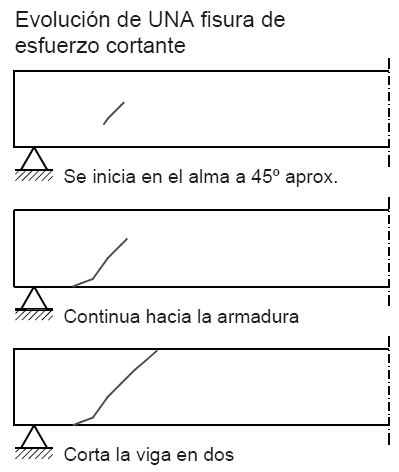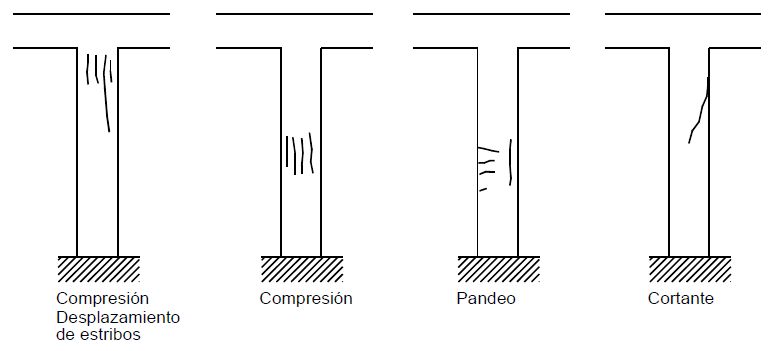Por el Lic. Pablo Tozzi
El pórtico es una de las formas estructurales más utilizadas en la aplicación del hormigón armado a la construcción de edificios, tanto por su rigidez como por su sencillez. Pero existen patologías a considerar, tanto desde el punto de vista funcional como estético.
Uno de los problemas más típicos es la aparición de fisuras, ya que tiene diversas causas. Podría tratarse de la retracción hidráulica del material, que aunque es una lesión leve, puede afectar a la durabilidad o podría ser por salto térmico, causada por un aumento de volumen cuando se incrementa la temperatura. Estas aparecen en las zonas traccionadas de las cabezas y las bases de los pilares, induciendo a las barras a movimientos de contracción.
Uno de los recursos más habituales para prevenir estas fisuras es disponer juntas de dilatación que limiten las deformaciones originadas por cambios de temperatura.
También son muy propias de este tipo de estructuras las lesiones causadas por el descenso diferenciado de un punto de la cimentación con respecto al resto. Esto provoca una desviación angular que genera deformaciones y roturas en las vigas.
FISURAS POR CORTANTE

“Aparecen fisuras motivadas por el alargamiento de la diagonal que une el pie o vértice con el opuesto”, afirma el Arquitecto Damián Fermín.
El cedimiento de una zapata producirá esfuerzos excepcionales que generará un deslizamiento en las armaduras por adherencia insuficiente.
Estas fisuras no aparecen de forma inmediata, manifestándose primero en la tabiquería y en la inclinación de los forjados. En este punto, la calidad del hormigón de los pilares será fundamental en cuanto a la seguridad.
Las fisuras menores de 0,3 mm no suelen provocar efectos serios sobre las estructuras de hormigón, pero si se acercan a los 2mm pueden repercutir en la funcionalidad y seguridad.
“Primero hay que definir si esa fisura se convirtió en grieta, y luego hacer un diagnóstico para determinar si puede afectar a la estructura”, asegura el patólogo Pablo Azqueta.
La rotura por aplastamiento es otra de las principales afeccciones que se produce por un exceso de carga, por armaduras insuficientes o por hormigón de baja calidad, dando origen a fisuras que pueden llegar a cortar en dos al pilar.
El aplastamiento produce un pandeo de la armadura en las esquinas originando fisuras que pueden confundirse con las de corrosión de las barras, pero que si al observar la cara opuesta del pilar esta aparece partida, no hay lugar a confusión.
Una solución de rápida ejecución es reforzar por medio de perfiles metálicos o integrar una armadura adicional, aplicando resina epoxi antes de hormigonar de nuevo.
FISURAS DE COMPRESIÓN

En los pórticos con nudos rígidos, las roturas suelen producirse por flexión. Esto se manifiesta a través de fisuras horizontales superiores, que pueden deberse a empujes horizontales, sobrecargas, mala resistencia del hormigón o deficiencias en el cálculo.
“El 40% de los procesos patológicos se deben a fallas de diseño y un 20% a fallas de ejecución”, advierte Azqueta desviando la atención en los materiales.
Las fisuras que se desplazan de abajo hacia arriba perdiendo anchura hasta desaparecer en la parte superior, indican una superación de las tensiones de tracción y se trata de una lesión estructural grave porque los pilares traccionados dejan de transmitir las cargas al terreno y otros han de asumir esa función aumentando el esfuerzo para el que fueron dimensionados.
En los pilares altos y esbeltos aparecen generalmente las fisuras por pandeo, que se manifiestan de forma horizontal, porque sus armaduras son insuficientes. Por eso la terapia más efectiva en estos casos es aumentar su dimesión mediante una armadura adicional.
La aparición de fisuras a 45° cercanas a sus apoyos sobre los pilares son indicio de una falla por esfuerzo cortante ocasionado por insuficiencia de las armaduras transversales o por baja resistencia del hormigón. Estas pueden producirse en la planta baja de edificios sometidos a fuertes empujes horizontales o en pilares de última planta que soportan grandes vigas.
English version
Pathologies in contributed structures
By Pablo Tozzi
The portico is one of the structural forms most used in the application of reinforced concrete to the construction of buildings, both for its rigidity and its simplicity. But there are pathologies to consider, both from the functional and aesthetic point of view.
One of the most typical problems is the appearance of fissures, since it has several causes. It could be the hydraulic retraction of the material, which although it is a slight injury, it can affect the durability or it could be by thermal jump, caused by an increase in volume when the temperature increases. These appear in the tractioned areas of the heads and the bases of the pillars, inducing the bars to contraction movements.
One of the most common resources to prevent these cracks is to provide expansion joints that limit the deformations caused by temperature changes.
Also very typical of this type of structure are the injuries caused by the differentiated descent of one point of the foundation with respect to the rest. This causes an angular deviation that generates deformations and breaks in the beams.
CUTTING FISSURES

«They appear fissures motivated by the lengthening of the diagonal that unites the foot or vertex with the opposite one», affirms the Architect Damián Fermín.
The release of a shoe will produce exceptional efforts that will generate a slip in the reinforcement due to insufficient adhesion.
These fissures do not appear immediately, manifesting first in the partition and in the inclination of the slabs. At this point, the quality of the concrete of the pillars will be fundamental in terms of safety.
Fissures smaller than 0.3 mm do not usually cause serious effects on concrete structures, but if they approach 2 mm they can affect functionality and safety.
«First you have to define if that fissure became a crack, and then make a diagnosis to determine if it can affect the structure,» says pathologist Pablo Azqueta.
The breakage by crushing is another of the main affections that is produced by an excess of load, by insufficient reinforcement or by low quality concrete, giving rise to cracks that can cut the pillar in two.
The crushing produces a buckling of the armor in the corners causing cracks that can be confused with the corrosion of the bars, but if you see the opposite side of the pillar is broken, there is no confusion.
A quick-acting solution is to reinforce by means of metal profiles or to integrate an additional reinforcement, applying epoxy resin before concreting again.
COMPRESSION FISSURES

In frames with rigid knots, breaks usually occur due to bending. This is manifested through upper horizontal fissures, which may be due to horizontal thrusts, overloads, poor concrete strength or deficiencies in the calculation.
«40% of the pathological processes are due to design failures and 20% to execution failures,» warns Azqueta, diverting attention to the materials.
The fissures that move from bottom to top, losing width until disappearing in the upper part, indicate an exceeding of the tensile stresses and it is a serious structural damage because the tractioned pillars stop transmitting the loads to the ground and others have to assume that function increasing the effort for which they were sized.
On the high and slender pillars, the buckling fissures usually appear, which manifest themselves horizontally, because their armor is insufficient. Therefore, the most effective therapy in these cases is to increase its dimension by means of additional armor.
The appearance of fissures at 45 ° close to their supports on the pillars are indicative of a shear failure caused by insufficient transverse reinforcement or low resistance of the concrete. These can occur on the ground floor of buildings subjected to strong horizontal thrusts or on top-level pillars that support large beams.
